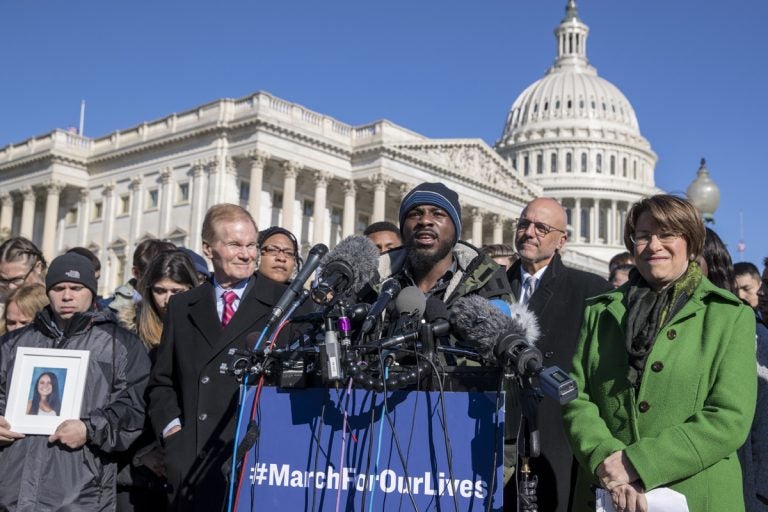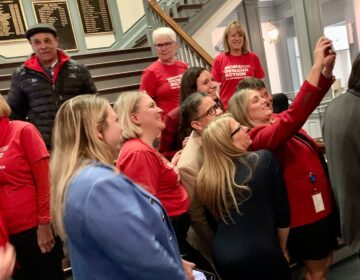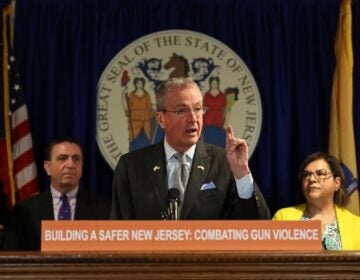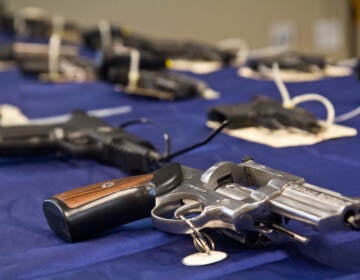Students and teachers need resources, not armed camps
Students do not need more firepower, police, metal detectors, and other trappings of the school-to-prison pipeline in their schools.

Robert Edwards, center, a student from Washington, speaks alongside lawmakers and gun control activists at the U.S. Capitol on Friday, March 23, 2018, a day before the March for Our Lives rally. (AP Photo/J. Scott Applewhite)
The rise of the #NeverAgain movement — hatched from the grief and anger of the survivors of the Marjorie Stoneman Douglas High School massacre in Parkland, Florida — has placed the issue of students and their needs on the front burner like never before. Although the young people are rallying around gun control and demanding an end to violence in their schools, the larger issue is that America has the wrong priorities in education.
As some politicians and the NRA call for arming teachers, the reality is students do not need more firepower, police or metal detectors. Rather, they need highly paid teachers, academic programs that build citizens and critical thinkers, strong extracurricular programs in music, art, sports, debating and other activities, not preparation to become inmates and armed camp detainees.
Already, in a few weeks the millennial-led movement has spurred student walkouts and protests across the country and today’s March for Our Lives in Washington, D.C., and forced the passage of a gun law, however inadequate, in the NRA laboratory of Florida. President Donald Trump and other water carriers for the gun lobby have promoted the concept of teachers carrying firearms purportedly as a means of stopping school shooters, but effectively as a method of selling more weapons and moving the subject away from prevention, gun regulations, and the needs of schools.
Emma González, one of the Parkland survivors, called the arming of teachers “stupid” on “60 Minutes,” noting the financial and practical limitations of the idea and its warped priorities.
“First of all, Douglas ran out of paper for, like, two weeks in the school year, and now all of a sudden they have $400 million to pay for teachers to get trained to arm themselves?” she said. “Really? Really?
“If you’re a teacher, and you have a gun, do you keep it in a lockbox or do you carry it on your person?” González continued. “If the teacher dies and a student who’s a good student is able to get the gun, are they now held responsible to shoot the student who’s come into the door? I’m not happy with that.”
The militarization of public schools and penalization of education arrived quite some time ago in black, Latino, and poor communities, where mass shootings never have occurred, yet students are subjected to metal detectors and pat-downs, zero-tolerance policies, and on-campus police arrests. When society retrofits its schools with the look and feel of correctional institutions, it sends a message that our children are prison ready, and this is the future we have carved out for them.
Meanwhile, the students at Marjorie Stoneman Douglas are effective and articulate speakers and leaders in the making, thanks to a debate program and a commitment to teaching civic education that many schools lack. This, as the country witnesses cuts to music, arts, and foreign language programs that build better human beings. Under the stumbling Secretary of Education Betsy DeVos, the Trump administration is hollowing out public education with deep cuts and a privatization scheme to “advance God’s kingdom” in the name of “school choice.”
The challenges facing teachers and students is evident in states such as West Virginia, where teacher pay ranks 48th among the 50 states. Teachers waged a strike for higher salaries, and they packed lunches for their students to make sure they did not go hungry, in a state where one in four children lives in poverty. Inspired by the West Virginia strike, teachers in other states are following suit and reinvigorating the labor rights movement.
And students are protesting — for their very lives and policies that are responsive to their lives. Young people always have been instrumental in social change, such as the civil rights and antiwar movements. Fifty years ago this month, Mexican-American high school students — facing racially discriminatory policies that discouraged them from higher learning — waged the East Los Angeles Walkouts. Chicano students who walked out of class made a number of demands to the board of education, sought the revision of textbooks, bilingual education and ethnic studies, Latino teachers and administrators, smaller classes, and better facilities. The walkout brought attention to the Chicano movement and politically empowered kids to fight against substandard education, express their sense of pride, and control their own destiny in the process.
Fast-forward half a century to a new generation, when young people have once again taken matters into their own hands because they cannot wait for the grown folks to do the right thing. The adults have failed the children, after demonstrating that they have the will to provide police officers and soldiers with all the firepower and equipment they need — and much of what they don’t need — and teachers with the weapons they don’t want, but lack the resolve to give children the tools they need to thrive.
WHYY is your source for fact-based, in-depth journalism and information. As a nonprofit organization, we rely on financial support from readers like you. Please give today.




